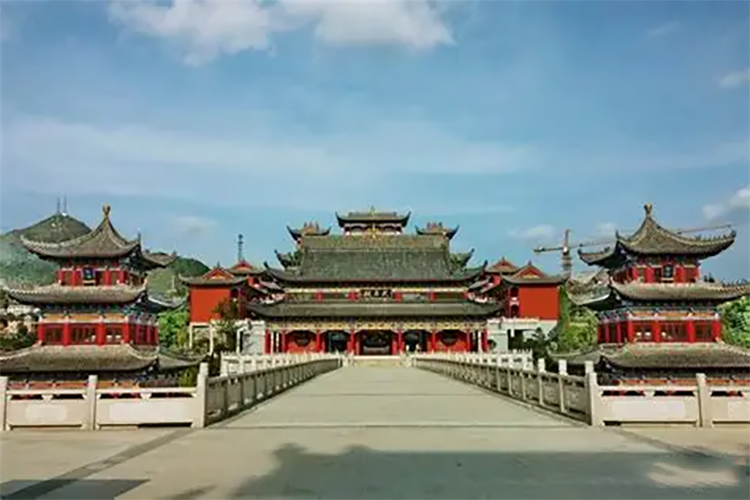Zen Meditation in Guiyang: Explore Daxingguo Temple, a 600-Year Sanctuary
1. A Timeless Zen Retreat
Nestled among the green hills of Huaxi District in Guiyang lies Daxingguo Temple, a 600-year-old Buddhist monastery that offers a rare pocket of calm inside Guizhou province. At dawn, when sunlight slips under the eaves and falls across the worn bluestone path, the temple bell rings and incense wafts through the courtyards—moments that make time feel still. Founded during the Ming dynasty’s Hongwu era, this Chan (Zen) temple is both an important symbol of Guizhou Buddhist culture and a peaceful refuge for modern travelers seeking quiet reflection.
2. Historical Overview: From Ming Dynasty Foundation to Cultural Landmark
Daxingguo Temple dates back to the Hongwu years (1368–1398), established by imperial decree and standing for more than six centuries. As one of Guizhou’s oldest Buddhist sites, it has witnessed the rise and fall of dynasties, survived conflicts, and undergone careful restorations. A Ming-era bronze bell inside the complex—over a thousand jin in weight and engraved with ornate Buddhist motifs and inscriptions—remains a vital artifact for scholars of Ming Buddhist art. Many of the current structures were rebuilt during major Qing dynasty restorations, yet the original Ming layout and spiritual character persist. Today the temple is a protected cultural site and an active place of practice that draws pilgrims and visitors who come to experience historical depth and Zen ambiance.
3. Architecture and Art: Exemplars of Ming-Qing Buddhist Design
(1) Exacting Temple Layout
Built into the mountain slope, Daxingguo follows the traditional Chinese Buddhist axial plan: mountain gate, Heavenly Kings Hall, Mahavira Hall (Daxiong Baodian), Guanyin Pavilion, and other core buildings. This tiered progression symbolizes the spiritual ascent from the secular world into the Buddha’s realm.
(2) The Mahavira Hall: The Temple’s Radiant Center
The Mahavira Hall is the temple’s spiritual heart, housing gilded statues of Sakyamuni, Bhaisajyaguru (Medicine Buddha), and Amitabha—representations of the past, present, and future. Their serene expressions and finely carved drapery reflect the skill of Ming and Qing artisans. Soft light, flickering incense, and quiet devotion create an atmosphere well suited to contemplation.
(3) The Ming Bronze Bell: Echoes of History
One of the temple’s most treasured relics is a massive bronze bell cast in the Ming period. Still resonant after centuries, its clear tones are struck at dawn and dusk, filling the mountain air with sound that many visitors describe as cleansing for the spirit.

4. Religious Activities and Immersive Experiences
(1) Dawn and Dusk Rituals
Daxingguo remains an active monastery with daily monastic rhythms. Early morning chanting and evening drum-and-bell ceremonies are open to respectful observation. Travelers may sit quietly and listen to sutra recitation to experience Chan discipline firsthand.
(2) Blessings and Incense Offerings
Visitors may purchase incense for a small donation (typically CNY 10–20) and follow local customs—holding incense with both hands and bowing with sincerity. You can also offer lamps or make voluntary donations at the merit box, but be cautious of unofficial vendors who may try to sell overpriced “good luck” services.
5. Setting and Atmosphere: Mountain Temple Tranquility
Unlike city temples, Daxingguo sits amid woodlands and fresh mountain air. Ancient trees and occasional bird calls add to the meditative ambiance. The visitor profile tends toward devout worshippers and travelers seeking inner quiet, so the overall feeling is solemn and peaceful.
6. Practical Itinerary Tips
– Suggested visit length: 1–2 hours (extend to a half-day for deeper immersion).
– Ideal for: Buddhist culture enthusiasts, heritage photographers, and those seeking quiet reflection.
– Combine with nearby attractions like Huaxi Park and Qingyan Ancient Town for a full “nature + culture” day tour.
7. Practical Information and Visitor Advice
– Dress code: Wear respectful, modest clothing; avoid shorts, short skirts, or sleeveless tops.
– Behavior: Keep voices low inside halls; turn off camera flash when photographing.
– Opening hours: 08:00–17:00 (mornings recommended to catch early rituals).
– Getting there: By public bus to Huaxi District, then local bus or taxi; driving and parking available (parking fee around CNY 10 per visit).
– Fees and payment: No entrance fee. Incense and donations accept cash and mobile payment; signage is mostly bilingual but guided explanation services are typically in Chinese.
8. Local Insights
– Best time to visit: Early morning between 07:00–09:00 for tranquil atmosphere and morning chanting.
– Quiet spot: Beneath the ancient tree behind the Guanyin Pavilion is a favored place for meditation.
– Watch-outs: Avoid street-side fortune-tellers outside the temple grounds.

9. Conclusion: A 600-Year Journey for the Heart
Daxingguo Temple is more than an architectural relic—it’s a living Chan monastery where history, ritual, and natural beauty converge. Whether you’re drawn by Ming-dynasty art, Buddhist practice, or simply a desire for stillness, this 600-year sanctuary in Guiyang offers a meaningful retreat worth making time for.


